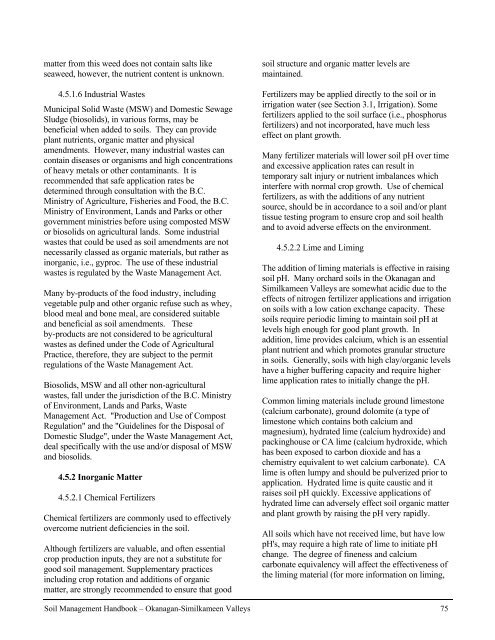Soil Management Handbook - Ministry of Agriculture and Lands
Soil Management Handbook - Ministry of Agriculture and Lands
Soil Management Handbook - Ministry of Agriculture and Lands
Create successful ePaper yourself
Turn your PDF publications into a flip-book with our unique Google optimized e-Paper software.
matter from this weed does not contain salts like<br />
seaweed, however, the nutrient content is unknown.<br />
4.5.1.6 Industrial Wastes<br />
Municipal Solid Waste (MSW) <strong>and</strong> Domestic Sewage<br />
Sludge (biosolids), in various forms, may be<br />
beneficial when added to soils. They can provide<br />
plant nutrients, organic matter <strong>and</strong> physical<br />
amendments. However, many industrial wastes can<br />
contain diseases or organisms <strong>and</strong> high concentrations<br />
<strong>of</strong> heavy metals or other contaminants. It is<br />
recommended that safe application rates be<br />
determined through consultation with the B.C.<br />
<strong>Ministry</strong> <strong>of</strong> <strong>Agriculture</strong>, Fisheries <strong>and</strong> Food, the B.C.<br />
<strong>Ministry</strong> <strong>of</strong> Environment, L<strong>and</strong>s <strong>and</strong> Parks or other<br />
government ministries before using composted MSW<br />
or biosolids on agricultural l<strong>and</strong>s. Some industrial<br />
wastes that could be used as soil amendments are not<br />
necessarily classed as organic materials, but rather as<br />
inorganic, i.e., gyproc. The use <strong>of</strong> these industrial<br />
wastes is regulated by the Waste <strong>Management</strong> Act.<br />
Many by-products <strong>of</strong> the food industry, including<br />
vegetable pulp <strong>and</strong> other organic refuse such as whey,<br />
blood meal <strong>and</strong> bone meal, are considered suitable<br />
<strong>and</strong> beneficial as soil amendments. These<br />
by-products are not considered to be agricultural<br />
wastes as defined under the Code <strong>of</strong> Agricultural<br />
Practice, therefore, they are subject to the permit<br />
regulations <strong>of</strong> the Waste <strong>Management</strong> Act.<br />
Biosolids, MSW <strong>and</strong> all other non-agricultural<br />
wastes, fall under the jurisdiction <strong>of</strong> the B.C. <strong>Ministry</strong><br />
<strong>of</strong> Environment, L<strong>and</strong>s <strong>and</strong> Parks, Waste<br />
<strong>Management</strong> Act. "Production <strong>and</strong> Use <strong>of</strong> Compost<br />
Regulation" <strong>and</strong> the "Guidelines for the Disposal <strong>of</strong><br />
Domestic Sludge", under the Waste <strong>Management</strong> Act,<br />
deal specifically with the use <strong>and</strong>/or disposal <strong>of</strong> MSW<br />
<strong>and</strong> biosolids.<br />
4.5.2 Inorganic Matter<br />
4.5.2.1 Chemical Fertilizers<br />
Chemical fertilizers are commonly used to effectively<br />
overcome nutrient deficiencies in the soil.<br />
Although fertilizers are valuable, <strong>and</strong> <strong>of</strong>ten essential<br />
crop production inputs, they are not a substitute for<br />
good soil management. Supplementary practices<br />
including crop rotation <strong>and</strong> additions <strong>of</strong> organic<br />
matter, are strongly recommended to ensure that good<br />
soil structure <strong>and</strong> organic matter levels are<br />
maintained.<br />
Fertilizers may be applied directly to the soil or in<br />
irrigation water (see Section 3.1, Irrigation). Some<br />
fertilizers applied to the soil surface (i.e., phosphorus<br />
fertilizers) <strong>and</strong> not incorporated, have much less<br />
effect on plant growth.<br />
Many fertilizer materials will lower soil pH over time<br />
<strong>and</strong> excessive application rates can result in<br />
temporary salt injury or nutrient imbalances which<br />
interfere with normal crop growth. Use <strong>of</strong> chemical<br />
fertilizers, as with the additions <strong>of</strong> any nutrient<br />
source, should be in accordance to a soil <strong>and</strong>/or plant<br />
tissue testing program to ensure crop <strong>and</strong> soil health<br />
<strong>and</strong> to avoid adverse effects on the environment.<br />
4.5.2.2 Lime <strong>and</strong> Liming<br />
The addition <strong>of</strong> liming materials is effective in raising<br />
soil pH. Many orchard soils in the Okanagan <strong>and</strong><br />
Similkameen Valleys are somewhat acidic due to the<br />
effects <strong>of</strong> nitrogen fertilizer applications <strong>and</strong> irrigation<br />
on soils with a low cation exchange capacity. These<br />
soils require periodic liming to maintain soil pH at<br />
levels high enough for good plant growth. In<br />
addition, lime provides calcium, which is an essential<br />
plant nutrient <strong>and</strong> which promotes granular structure<br />
in soils. Generally, soils with high clay/organic levels<br />
have a higher buffering capacity <strong>and</strong> require higher<br />
lime application rates to initially change the pH.<br />
Common liming materials include ground limestone<br />
(calcium carbonate), ground dolomite (a type <strong>of</strong><br />
limestone which contains both calcium <strong>and</strong><br />
magnesium), hydrated lime (calcium hydroxide) <strong>and</strong><br />
packinghouse or CA lime (calcium hydroxide, which<br />
has been exposed to carbon dioxide <strong>and</strong> has a<br />
chemistry equivalent to wet calcium carbonate). CA<br />
lime is <strong>of</strong>ten lumpy <strong>and</strong> should be pulverized prior to<br />
application. Hydrated lime is quite caustic <strong>and</strong> it<br />
raises soil pH quickly. Excessive applications <strong>of</strong><br />
hydrated lime can adversely effect soil organic matter<br />
<strong>and</strong> plant growth by raising the pH very rapidly.<br />
All soils which have not received lime, but have low<br />
pH's, may require a high rate <strong>of</strong> lime to initiate pH<br />
change. The degree <strong>of</strong> fineness <strong>and</strong> calcium<br />
carbonate equivalency will affect the effectiveness <strong>of</strong><br />
the liming material (for more information on liming,<br />
<strong>Soil</strong> <strong>Management</strong> <strong>H<strong>and</strong>book</strong> – Okanagan-Similkameen Valleys 75
















